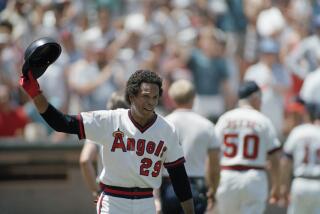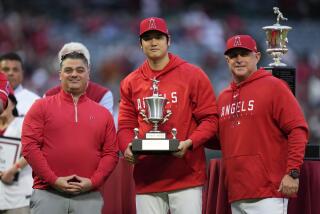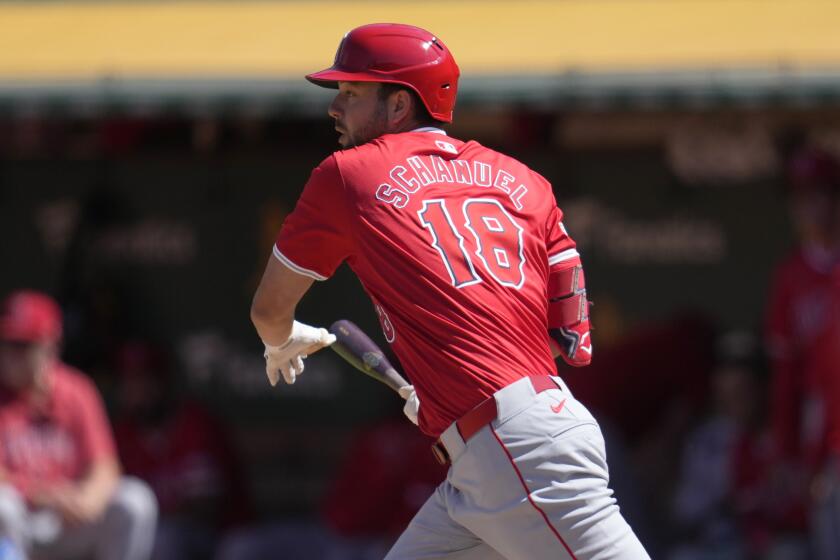Getting to the Ballpark -- or Around It -- Can Be Daunting
It’s baseball season, and with so many people taking themselves out to the ballgame it’s time to look at that secondary sport of summer -- getting to the ballpark. Or more accurately for some folks, getting around Dodger Stadium or Edison Field if what you really want to do is get home from work on a game day.
Dodger Stadium can accommodate nearly 19,000 cars, said communications chief Derrick Hall. On opening day this month, about 16,000 vehicles converged on the Chavez Ravine facility, which is smack in the middle of L.A.’s Echo Park neighborhood and on the commuting routes of people who live there as well as in Atwater Village, Eagle Rock, Glendale, Pasadena, Silver Lake and other points north and east of downtown.
To ease congestion, the Dodgers have set up a shuttle service between Union Station downtown and the ballpark. Fans pay $2 for the ride, which the club points out is cheaper than the $8 cost of parking a car with fewer than four people in it.
But the shuttle only runs when there are Friday night home games or other big weekday draws, such as opening day, when traffic is likely to be heavy. A complete schedule can be found on the Metropolitan Transportation Authority’s Web site at www.mta.net/metro_ transit/special_services/dodger _shuttle.
For its debut on opening day earlier this month, 300 to 500 people rode the shuttle. But most of them were people who needed public transportation to get to the game, Hall said. People with cars drove anyway, he said.
“We need to get people who would normally use cars to utilize the service,” Hall said.
The problem is all the more obvious at Edison Field in Anaheim, where the Angels play.
The stadium, which seats 45,000 people but has just 12,000 parking spaces, has a train station on the premises.
But the Metrolink trains that go there stop running about 7 p.m. -- far too early to take people home from night games. Amtrak runs trains through the station until about 11 p.m., and Metrolink passengers with monthly passes can ride for free, as long as their regular commuting routes include Anaheim.
But few fans take advantage of the trains. “A lot of people don’t take trains to the baseball games because it’s logistically difficult,” said Metrolink spokeswoman Sharon Gavin. The exceptions, she said, are charter trains to specific games organized by local sporting and transit organizations.
By contrast, Staples Center in downtown Los Angeles and ballparks in San Francisco and Oakland are easily served by rail lines. In Seattle, the bus service includes six special game-day routes between Safeco Field and area park-and-ride lots, in addition to 25 other bus routes within two blocks of the ballpark.
Staples Center is less than two blocks from the Metro Blue Line station at Pico Boulevard and 12th Street, and four blocks from a Metro Red Line stop at 11th and Figueroa streets. So many people attending L.A. Kings or Lakers games have used the subway that the MTA has added extra trains to accommodate them, said Staples Center spokesman Michael Roth.
Parking a car at the downtown arena is more complicated, Roth said. Staples Center has several lots, and none can be reached by simply driving up to the building’s front door.
“One of the biggest tips for coming to Staples Center is to plan ahead,” he said. “Go on the Web site or have us send you a map of all of the various parking lots.” (The Staples Center site is at www.staplescenter.com.)
The staggered lots, Roth said, are meant to keep traffic flowing around Staples Center, alleviating the massive tie-up that would be caused if there were a single exit or entrance.
But William Morales, who works at a downtown Starbucks cafe and commutes to 114th and Main streets in South-Central L.A., said when there are events or games at Staples Center he would rather go all the way home on Broadway than deal with getting on the Harbor Freeway. “When the Lakers or the Kings are playing, you know there’s going to be a traffic jam,” he said.
At Dodger Stadium, the Department of Transportation has begun setting out signs along the side streets a day before home games, urging commuters and residents to change their routes to avoid congestion.
On opening day, the city collaborated with the ballpark on a plan to keep fans from parking on the roads around the stadium, issuing parking passes to local residents and steering fans away from residential streets.
In 1999, stadium officials closed the Scott Street entrance to the park, alleviating a massive tie-up that made it hard for residents to get to their homes and led to complaints that drunken fans were fighting, urinating and shouting on the way to their parked cars.
For residents and commuters, the options for dealing with the every-summer traffic crunch are somewhat limited.
Drivers who normally would take Sunset Boulevard home from work downtown can switch to Temple Street to avoid the biggest surface street crush of fans heading to night games.
But the stadium’s location among three freeways, theoretically an advantage, guarantees at least some traffic jams wherever you go. “The good thing about Dodger Stadium is that it’s centrally located among all three of the freeways,” Hall said. “But the bad thing about Dodger Stadium is that it’s centrally located among all the freeways.”
The team has lobbied for a dedicated exit from the Pasadena Freeway or the Golden State Freeway, but to no avail, Hall said.
Paul Dinh-McCrillis, who commutes between downtown and Burbank on the Pasadena and Golden State freeways, said he has given up trying to find a route around the stadium traffic.
“When its backed up, I just turn up the music loud,” said Dinh-McCrillis, an associate casting director for the Mark Taper Forum and Ahmanson Theater. “Because there’s nothing you can do. It’s L.A. traffic and if it’s not bogged down one place it’s bogged down in another. What’s the point of getting worked up about it?”
Jack Williamson, an economist who works downtown and commutes to Silver Lake via a similar route, said he would rather brave the extra freeway traffic on game nights than venture through local neighborhoods on surface streets.
“Sometimes I see all the traffic and I think of glorious Dodger victories of the past,” he said, recalling the team’s magical 1988 season and the ninth-inning homer that helped win the World Series. “The traffic is a small price to pay for the memory of Kirk Gibson’s home run.”
More to Read
Go beyond the scoreboard
Get the latest on L.A.'s teams in the daily Sports Report newsletter.
You may occasionally receive promotional content from the Los Angeles Times.






